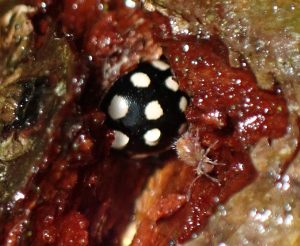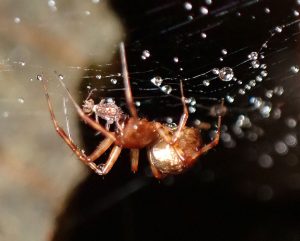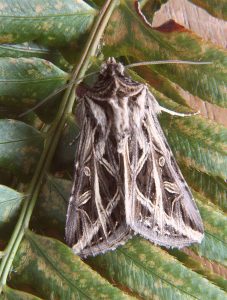2025 January 7
2025 January 7
Here are two more photographs from Ian Cooper’s 2024 January 5 photoshoot:
 Lady Beetle Calvia quatuordecimguttata (Col.: Coccinellidae) Ian Cooper
Lady Beetle Calvia quatuordecimguttata (Col.: Coccinellidae) Ian Cooper
Also in the picture is a globose springtail, which would be well advised to stay out of the way of the lady beetle. If I remember my Latin correctly (writes Jeremy Tatum), XIV is spelled quattuordecim, with two ts. But, if the first person to describe and name a species new to science spells it wrongly, the name given must stick.
 Linyphiid spider (Ara.: Linyphiidae) Ian Cooper
Linyphiid spider (Ara.: Linyphiidae) Ian Cooper
Globose springtails should also keep out of the way of linyphiid (or other) spiders. The one in this photograph obviously didn’t.
A nice surprise for Jeremy Tatum along Carey Road today – this handsome moth. There are several (many?) noctuid moths that overwinter as imagines, but I didn’t realize that this one did. [My computer says I have made a mistake with grammar in the previous sentence. Apparently, it doesn’t like “as imagines”. I don’t see what’s wrong with it.]
 Girdler Moth Dargida procinctus (Lep.: Noctuidae) Jeremy Tatum
Girdler Moth Dargida procinctus (Lep.: Noctuidae) Jeremy Tatum
I don’t know how this moth acquired the English name of “Girdler”. The caterpillars feed on grasses.
The spellings procinctus and procincta are both to be found in the literature. On this site, since 2024, we are following spellings given in the ATC.
